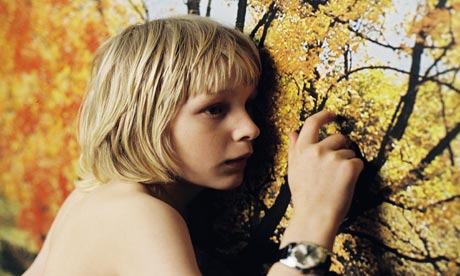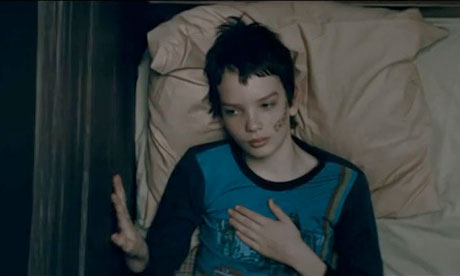I am sitting in Austin's Paramount Theater, a former opera house and one of the most beautiful Classic Revival venues in the country, holding a test tube full of green liquid I can only assume (and hope) is Jell-O and very strong booze, watching several grown men in Viking costumes stomping around to Led Zeppelin onstage. They are followed by a hauntingly lovely choral performance from a gaggle of angelic-looking preadolescent boys in red robes and comically large ruffs. Apparently as the two groups passed each other backstage one of the boys, fidgety in his choir robe, wistfully said to a Viking "I wish I was on your team." At Fantastic Fest, the largest genre film festival in the US but better known to its loyal fans as an epic week-long geekout, this collision of anarchic revelry, tongue-in-cheek irony, and sincere talent is the right way to kick things off.
This year's opening night film was the high profile vampire flick Let Me In, which would have packed the 1,000 seat theater even without surprise performances, highly anticipated as it was by both genre enthusiasts and foreign film snobs who hold the Swedish original, Let The Right One In (Thomas Alfredson), near and dear to their hearts. Showcasing a remake on opening night was not an inappropriate choice given the context; no genre has been mined for recyclable material like, well, genre. Fantastic Fest presented two other remakes this year; Im Sang-soo's take on classic Korean drama The Housemaid, and Steven R. Monroe's roughening up of iconic rape-revenge number I Spit On Your Grave. Notably, both films have been made decades after their originals, take place in the same culture, and even retain identical titles.
Adapting a beloved film to a new culture, however, particularly a more mainstream American one, less than two years after the release of the original raises some unsavory questions about intention. Director Matt Reeves has spoken frequently of his veneration for Alfredson's version -- is Let Me In homage, an honest desire to put a personal stamp on the story, or was it made for purely commercial reasons? The answer is most likely some uncomfortable combination of those factors. Having worked in distribution I understand the limitations of a foreign language film in the American market, but part of me wants to believe that a unique, well made movie that happens to be in Swedish could still have a shot. We'll have to see how Let Me In and David Fincher's upcoming remake of the Millennium Trilogy fare at the box office before drawing any conclusions about this new fangled predilection for looting Scandinavia for movie ideas.


The plot of Reeves' film is basically identical to the original. Owen (Kodi Smit-McPhee), a maladjusted, mercilessly bullied boy from a broken home, meets Abby (Chloe Moretz), an angst-ridden 12-year-old vampire trying to hide her identity while feeding her thirst. As their sweet but star-crossed friendship blossoms, so does it trigger a series of viciously tragic events. Of course what fans found so special about Let The Right One In is not just the cool creepy-kid twist on the Vampire genre, but also the unexpected poignancy of its protagonists' outsider romance, and the unnerving intersection of innocence and brutality. At the disturbing heart of both films is the idea that Abby is not the only monster in the story, that many children, bullies and victims alike, are inherently capable of cruelty.
Despite sharing the same major plot points and themes as its predecessor, Let Me In still feels like a completely different film; a distinctly American film. It is more tethered to time and place, creating a repressive 1980's suburban dystopia whose social and political concerns are woven into the general aura of isolation and anxiety. Let The Right One In reflects a Swedish sensibility in terms of pacing and dialogue but is overall relatively free from an outside world. The remake feels more American in terms of the general tone as well. The filmmaking choices are a little more on-the-nose, and despite having lifted several shots directly from the original (see the images above, and these side-by-side comparisons from Fearnet) everything is just a tiny bit glossier, as if sprinkled with a pinch of Hollywood fairy dust. The more color-saturated imagery is more pretty than gritty, the violence more spectacular, the sparseness of the original dialogue exaggerated beyond dry into stiff. This is not always a bad thing in terms of the viewing experience, other than the still upsetting fact that few will see the bleaker, more challenging original film.
So, is the US remake of Let The Right One In as good as the original? Surprisingly, kind of. Reeves is faithful but not slavish to the source material, completely rebuilding the context of the original story in a way that still does it justice. The strange mix of horror and nostalgia shines through the occasional heavy handedness that makes the film more accessible; the romance and revenge feel as sickeningly thrilling as ever. Let Me In even features a few truly brilliant moments, most notably a Krzysztof Kieslowski-inspired car crash sequence that is so elegantly disorienting it made me feel suspended in mid-air while taking place and awestruck when completed. Wide-eyed in that "this is what movies can do!" sort of way, I chose that particular moment to quietly down my vile green drink in admiration.